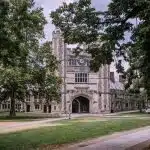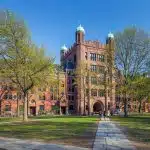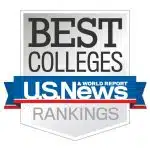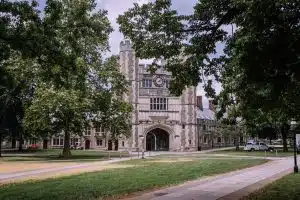Swarthmore College’s latest acceptance rate stands at 7.5% for the Class of 2028. Consistently ranked among the top three liberal arts colleges, Swarthmore attracts highly accomplished applicants, making the admissions process incredibly competitive. If you’re aiming for a spot at this prestigious college, your application needs to stand out.
In this blog, we’ll break down what Swarthmore’s acceptance rate really means, how it has evolved over time, and what you can do to maximize your chances of admission. Whether you’re applying through Early Decision, Regular Decision, or as a transfer student, understanding these numbers will help you develop a more strategic approach.
- What Is Swarthmore College’s Acceptance Rate?
- Swarthmore College Acceptance Rate Trends
- Swarthmore College Regular Decision Acceptance Rate
- Swarthmore College Early Action Acceptance Rate
- How to Get Accepted into Swarthmore College
- Swarthmore College Transfer Acceptance Rate
- Swarthmore College Waitlist Acceptance Rate
- Frequently Asked Questions
- Takeaways
What Is Swarthmore College’s Acceptance Rate?
The acceptance rate for Swarthmore College’s Class of 2028 was 7.5%. Out of 13,065 total applicants, only 974 were admitted. Let’s break down the numbers:
| Application Type | Total Applications | Accepted | Acceptance Rate |
| Regular Decision | 11,844 | 754 | 6.4% |
| Early Decision | 1,221 | 220 | 18% |
| Overall | 13,065 | 974 | 7.5% |
Swarthmore College’s Early Decision (ED) acceptance rate of 18.02% for the Class of 2028 is significantly higher than the Regular Decision (RD) acceptance rate of 6.37%, a trend consistent with previous years. While applying ED may offer a statistical advantage, admission remains highly competitive across all rounds.
Swarthmore College’s yield rate
Another important metric Swarthmore College tracks is its yield rate, which represents the percentage of admitted students who choose to enroll. For the Class of 2028, the yield rate was 43.8%, with 427 out of 974 admitted students deciding to attend.
To put this into perspective, the national average yield rate for four-year colleges in 2022 was 30%. Public colleges had an even lower average of 25%, while private colleges saw a 33% yield. Compared to these figures, Swarthmore remains well ahead.
Its consistently high yield rate underscores the college’s strong appeal and plays a role in its highly selective admissions process. By attracting highly committed students, Swarthmore ensures that each incoming class is filled with driven and engaged individuals.
Swarthmore College Acceptance Rate Trends
Swarthmore College has become increasingly difficult to get into, with its acceptance rate steadily declining over the past decade. Once in the double digits, the rate has now dropped to just 7.46% for the Class of 2028, making admission more competitive than ever.
We’ve gathered all recent data from the school’s Common Data Set. Let’s look at the trends:
| Swarthmore College Class | Total Applications | Overall Acceptance Rate |
| 2028 | 13,065 | 7.5% |
| 2027 | 14,287 | 6.9% |
| 2026 | 14,707 | 6.9% |
| 2025 | 13,012 | 7.8% |
| 2024 | 11,630 | 9.1% |
| 2023 | 11,442 | 8.9% |
| 2022 | 10,749 | 9.5% |
| 2021 | 9,382 | 10.7% |
| 2020 | 7,717 | 12.8% |
The numbers make it clear: gaining admission to Swarthmore is more competitive than ever. The rise in applications, partly driven by the school’s test-optional policy, has contributed to the lower acceptance rate.
However, the increase in applicants isn’t the only factor. Swarthmore continues to keep its incoming class size small, ensuring that admission remains highly selective. Beyond strong academic performance, the college seeks students with exceptional extracurricular involvement, leadership experience, and unique personal stories.
With acceptance rates dropping each year, academic excellence alone is no longer enough. Applicants must find ways to differentiate themselves and showcase what makes them truly stand out.
Swarthmore College’s acceptance rate vs other Ivy League schools
Swarthmore is often called a “Little Ivy” due to its prestige and selectivity. Understanding Swarthmore College’s acceptance rate in context provides insight into how it compares with Ivy League institutions. Here’s how Swarthmore stacks up against its peers:
| Ivy League School | Acceptance Rate (Class of 2028) |
|---|---|
| Harvard University | 3.6% |
| Yale University | 3.7% |
| Columbia University | 3.85% |
| Princeton University | 4.6% |
| Brown University | 5.2% |
| University of Pennsylvania | 5.4% |
| Cornell University | 8.4% |
| Dartmouth College | 5.3% |
While Ivy League schools such as Harvard (3.6%) and Yale (3.7%) have lower acceptance rates, Swarthmore remains one of the most selective liberal arts colleges in the country. One contributing factor to these differences is the size of the applicant pool. Universities like Harvard receive over 50,000 applications, naturally driving their acceptance rates lower.
Swarthmore’s acceptance rate (7.5%) may be slightly higher, but this does not make admission any less competitive. The college maintains a rigorous selection process, prioritizing academic excellence, intellectual curiosity, and meaningful engagement with the community. Applicants must present a compelling and well-rounded profile to stand out in this highly selective environment.
Swarthmore College Regular Decision Acceptance Rate
Swarthmore College’s Regular Decision (RD) acceptance rate for the Class of 2028 was just 6.37%, with only 755 students admitted from a pool of 11,844 applicants. While this marks a slight increase from the previous two years, it still reflects a highly competitive admissions process.
Why is RD typically more challenging? A key factor is Swarthmore’s Early Decision (ED) program, which secures a significant portion of the incoming class. With a higher ED acceptance rate, fewer spots remain for RD applicants, making the process even more selective.
Here’s how Swarthmore’s RD acceptance rates have changed over recent years:
| Swarthmore College Class | Total Regular Decision Applications | Regular Decision Acceptance Rate |
| 2028 | 11,844 | 6.4% |
| 2027 | 12,929 | 6.% |
| 2026 | 13,549 | 5.9% |
| 2025 | 12,028 | 6.5% |
| 2024 | 10,636 | 7.7% |
| 2023 | 10,450 | 7.5% |
| 2022 | 9,889 | 8.1% |
For context, Swarthmore’s RD acceptance rate was 8.03% in 2022 but has since declined, hitting a low of 5.88% for the Class of 2026. While the Class of 2028 saw a slight increase compared to recent years, the competition remains intense.
What does this mean for RD applicants? Strong grades alone aren’t enough. To stand out, applicants need compelling essays, impressive extracurriculars, and strong recommendation letters to have a real shot at admission.
Swarthmore College Regular Decision deadline and notification date
Swarthmore College’s Regular Decision deadline is January 4, with decisions typically announced in late March.
Swarthmore College Early Decision Acceptance Rate
Swarthmore College’s Early Decision (ED) acceptance rate for the Class of 2028 was 18.02%, with only 220 students admitted from a pool of 1,221 applicants. This marks a slight increase from the previous two years but remains significantly lower than earlier cycles, reflecting the increasing competitiveness of the ED process.
Here’s a breakdown of Swarthmore’s ED acceptance rates over the years:
| Swarthmore College Class | Total Early Action Applications | Early Action Acceptance Rate |
| 2028 | 1,221 | 18% |
| 2027 | 1358 | 15.9% |
| 2026 | 1158 | 19.2% |
| 2025 | 984 | 23.8% |
| 2024 | 994 | 23.8% |
| 2023 | 992 | 23.7% |
| 2022 | 860 | 26.3% |
Over the past several years, Swarthmore’s ED acceptance rate has declined from 26.28% for the Class of 2022 to 18.02% for the Class of 2028. Meanwhile, the number of ED applicants has increased, making admission more competitive.
Despite this trend, applying early can still provide an advantage. Swarthmore prioritizes filling a portion of its incoming class through ED, favoring applicants who demonstrate a strong commitment to attending. However, the ED applicant pool is highly competitive, meaning strong academics alone won’t be enough—you’ll need compelling essays, standout extracurriculars, and a well-rounded application to stand out.
It’s important to remember that Swarthmore’s ED program is binding, meaning admitted students are required to enroll. This option is best suited for those who are confident Swarthmore is their top choice.
One benefit of applying ED is receiving an admissions decision months earlier than RD applicants, providing clarity and peace of mind. However, rushing an application to meet the early deadline isn’t always the best move—if you need more time to strengthen your application, waiting for Regular Decision might be the smarter choice.
Swarthmore College Early Action deadline and notification date
Swarthmore College’s Early Decision (ED) deadline is November 15, with admissions decisions typically released by December 15.
How to Get Accepted into Swarthmore College
Planning to apply to Swarthmore College? The first step is submitting your application through either the Common or Coalition Application.
But getting your application in on time is just the beginning. Swarthmore takes a holistic approach to admissions, considering more than just grades and test scores. The committee looks for insightful essays, extracurricular activities that reflect genuine passion, and recommendation letters that offer a clear picture of who you are as a student and individual.
Here’s a breakdown of key factors that can help strengthen your application and boost your chances of admission.
Target GPA
Swarthmore College does not specify a minimum GPA, but admissions are highly competitive. While the 2024-2025 Common Data Set does not include specific GPA data, a 4.1 GPA is historically a strong indicator of a competitive applicant.
Swarthmore places a strong emphasis on the rigor of an applicant’s high school coursework, class rank, and overall GPA. Taking challenging AP, IB, or honors courses can demonstrate academic excellence and a commitment to intellectual growth.
That said, GPA is just one part of the holistic review process. The admissions committee also prioritizes application essays, recommendations, and personal qualities, meaning a compelling overall application can help offset a slightly lower GPA.
Target standardized test scores
Swarthmore College remains test-optional through at least the 2025-26 admissions cycle, meaning neither SAT nor ACT scores are required for first-year or transfer applicants.
For those who choose to submit test scores, strong results can strengthen an application. While Swarthmore does not have a minimum requirement, competitive scores can help applicants stand out. According to the latest Common Data Set, here are the middle 50% score ranges for admitted students:
| Standardized Test | 25th Percentile Score | 50th Percentile Score | 75th Percentile Score |
| SAT | 1500 | 1530 | 1550 |
| ACT | 33 | 34 | 35 |
Swarthmore’s admitted students tend to score in the top percentile nationally. While a perfect score is not required, aiming for a 1550 on the SAT or a 35 on the ACT can help place applicants in the most competitive range.
However, given the holistic admissions process, other factors like coursework rigor, essays, and extracurricular achievements remain just as important in the evaluation process.
Other requirements
Swarthmore College evaluates applicants holistically, considering more than just GPA and test scores. That’s why elements like extracurricular activities, essays, and recommendation letters play a crucial role in the admissions process.
- Extracurricular activities. Swarthmore values meaningful involvement, leadership, and impact over a long list of activities. Strong applicants engage in programs like the Sunrise Movement, MIT PRIMES, or the Simons Summer Research Program. Leadership in speech and debate, Model UN, or community-based initiatives also stands out. Commitments to social justice, civic engagement, or STEM competitions like Regeneron ISEF and USAMO further strengthen an application.
- Essays. The essay portion is a chance to showcase individuality and perspective. For the 2024-25 application cycle, applicants must submit a personal statement (via the Common App or Coalition App) along with two Swarthmore-specific supplemental essays, each limited to 250 words. Authenticity is key—essays should provide insight into personal values, experiences, and aspirations.
- Recommendation letters. Swarthmore requires three recommendation letters: two from teachers who can speak to an applicant’s academic strengths and intellectual curiosity, and one from a school counselor. Thoughtful and detailed letters can provide valuable context, so applicants should seek recommenders who know them well and can highlight their contributions in the classroom and beyond.
For a detailed breakdown of each application component, refer to our comprehensive guide to crafting a strong Swarthmore application.
Swarthmore College Transfer Acceptance Rate
According to Swarthmore College’s 2024-2025 Common Data Set, no transfer applicants were admitted due to space constraints. Out of 371 applicants, none received offers of admission.
Why is transferring to Swarthmore so difficult? The primary reason is the limited number of available spots. With most seats filled by first-year students, the college has little room for transfers, making the process highly competitive. In some years, as seen in 2024, no transfer spots are available at all.
Swarthmore College transfer requirements
Unlike first-year admissions, which take a holistic approach, Swarthmore College’s transfer process is far more limited and academically focused. Given the extremely low number of available spots, the college prioritizes students whose academic goals strongly align with its programs.
Here are the required transfer application materials:
- Common Application or Coalition Application
- $60 application fee or fee waiver (Swarthmore waives the fee for students currently enrolled in a community or junior college.)
- Official final high school transcript(s)
- Transfer College Report from your most recent college or university
- Official college transcript(s) from all previously or currently attended institutions
- Two academic evaluations, including at least one recommendation from a recent college instructor
- Transfer Mid-Term Report (required for applicants currently enrolled in college or university)
Swarthmore College Waitlist Acceptance Rate
Swarthmore College’s waitlist acceptance rate for the 2024-2025 cycle was 0%, meaning no students were admitted from the waitlist. While waitlist data for previous years shows occasional acceptances, admission remains highly competitive and uncertain due to space limitations.
What to do if you’re waitlisted
If you find yourself on Swarthmore’s waitlist, here are steps you can take to maximize your chances, even if they remain slim:
- Confirm your spot. Make sure that you are able to accept your place through their designated process. Failing to do so means you won’t be considered for admission.
- Submit a Letter of Continued Interest (LOCI). Express your strong desire to attend Swarthmore and update the admissions office on any recent achievements, awards, or projects since your initial application. This reinforces your commitment to the school.
- Second, provide additional materials. If Swarthmore permits, consider submitting updated transcripts, improved test scores, or an additional recommendation letter— but only if these materials significantly strengthen your application.
- Lastly, secure a backup plan. Since Swarthmore’s waitlist admission rates are unpredictable, it’s essential to commit to another college where you’ve been accepted. Keep your options open to ensure you have a solid path forward.
Being on Swarthmore’s waitlist is a challenging position, and while proactive steps may help, the best approach is to manage expectations and have alternative plans in place.
Frequently Asked Questions
1. What is Swarthmore College’s latest overall acceptance rate?
For the Class of 2028, Swarthmore College’s acceptance rate was 7.5%, with 13,065 applicants and 975 students admitted. This marks a continued trend of highly selective admissions.
2. What is Swarthmore College’s Early Action acceptance rate?
For the Class of 2028, Swarthmore’s Early Decision (ED) acceptance rate was 18%, with 220 students admitted from a pool of 1,221 applicants. This suggests that applying early can offer a slight advantage.
3. What is Swarthmore College’s Regular Decision acceptance rate?
For the Class of 2028, Swarthmore’s Regular Decision (RD) acceptance rate was 6.4%, with 755 students admitted out of 11,844 applicants.
4. What is Swarthmore College’s transfer acceptance rate?
For the 2024-2025 admissions cycle, Swarthmore College did not admit any transfer students due to space limitations. In previous years, transfer acceptance rates have been low, typically around 5-6%.
5. What is Swarthmore College’s waitlist acceptance rate?
For the 2024-2025 admissions cycle, no students were admitted from the waitlist due to space constraints. In prior years, waitlist acceptance rates have been extremely low. Acceptance from the waitlist remains highly competitive and unpredictable.
Takeaways
To understand Swarthmore College’s competitive admissions process and improve your chances, here are five essential insights:
- Swarthmore’s acceptance rate is just 7.5% for the Class of 2028, making it one of the most selective liberal arts colleges in the country.
- Swarthmore’s acceptance rate is on par with top universities. Swarthmore’s selectivity is comparable to some Ivy League schools, with a lower acceptance rate than Cornell (8.4%).
- Early Decision offers a clear advantage. For the Class of 2028, Swarthmore’s ED acceptance rate was 18%, significantly higher than the Regular Decision rate of 6.4%. This trend suggests that applying early can boost your chances.
- Competitive applicants should aim for a 4.1 unweighted GPA with a rigorous course load. For test scores, targeting a 1550 SAT or a 35 ACT composite puts you in range of admitted students. However, compelling essays, impactful extracurriculars, and strong recommendations are just as crucial.
- With such a low acceptance rate, strategic preparation is key. The admissions process is highly competitive, so crafting a standout application through working with a college admissions consultant could make a difference with your Swarthmore application.












































